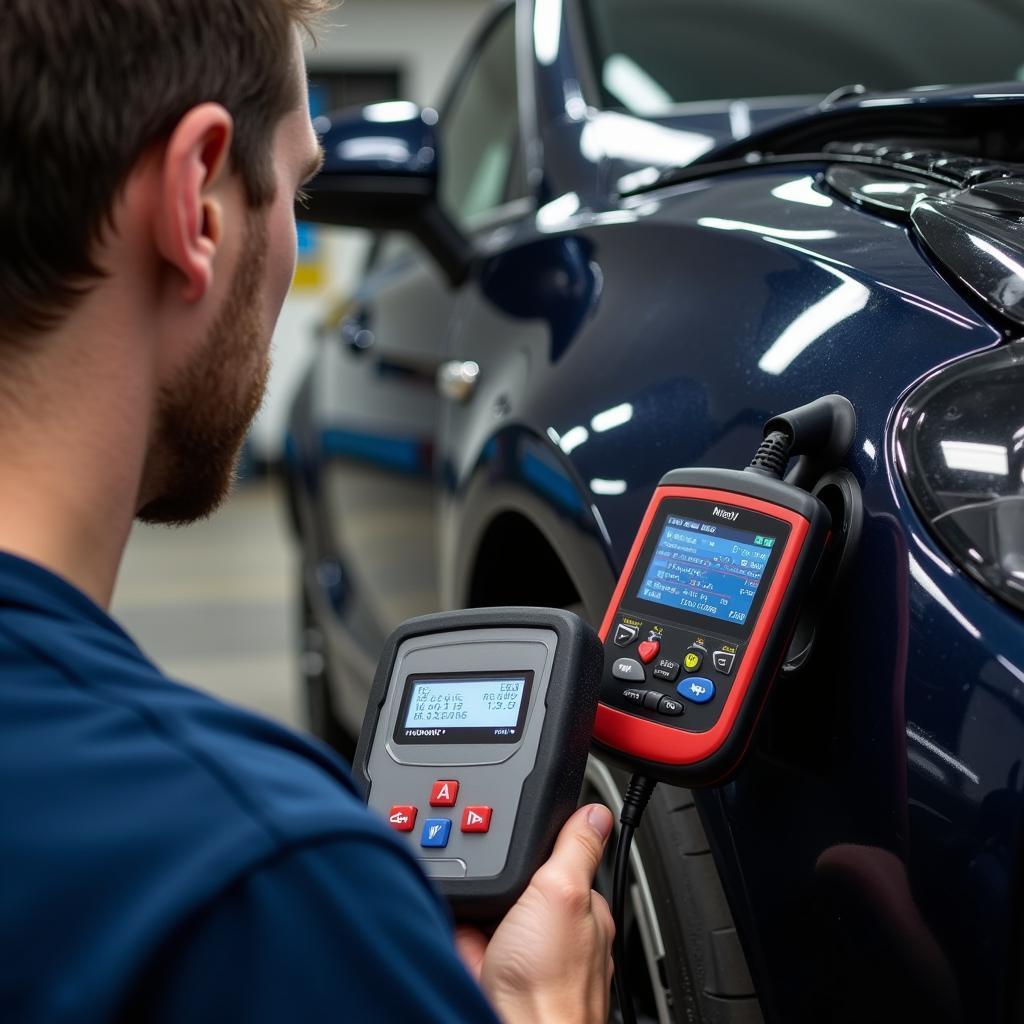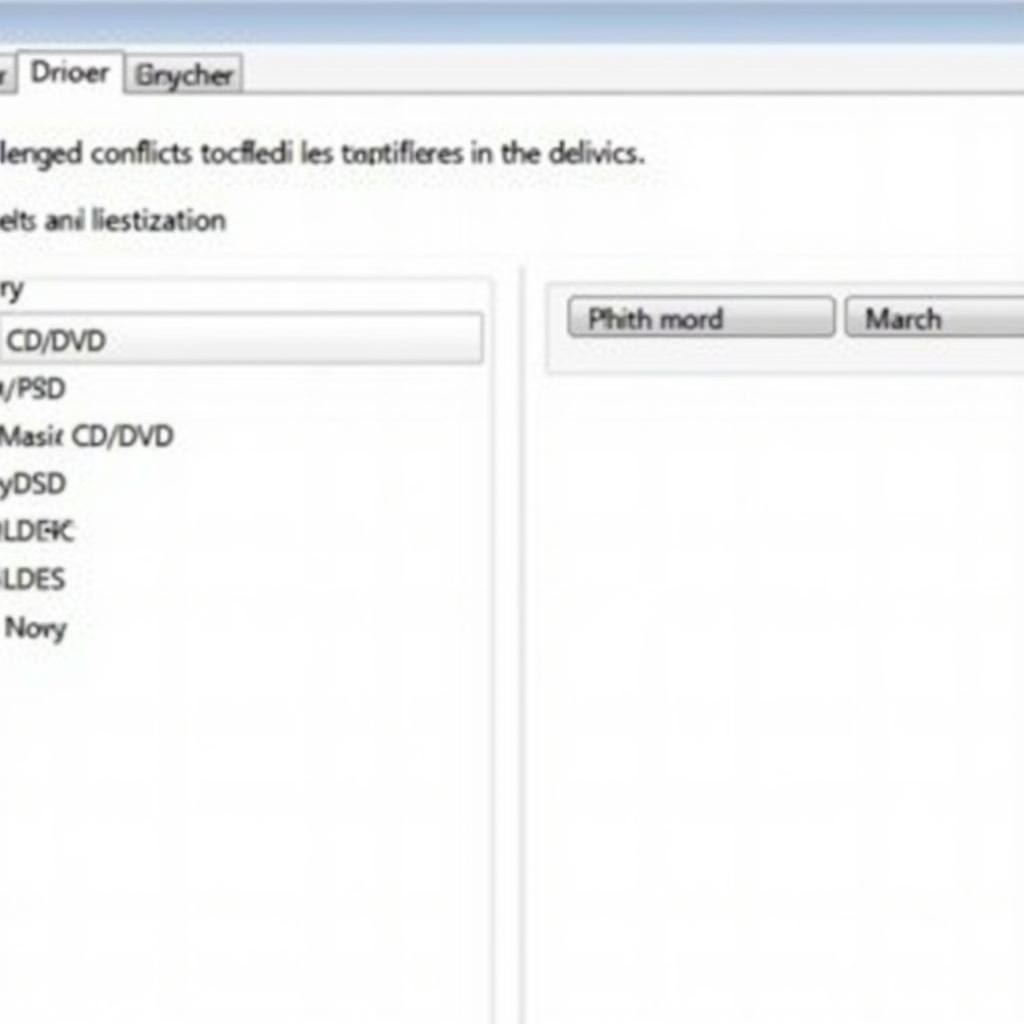In today’s automotive landscape, vehicles are becoming increasingly sophisticated, relying heavily on complex electronic systems for optimal performance. When your car throws a temperamental fit, a Vehicle Diagnostic Scanner Tool can be your trusted sidekick, helping you decipher those cryptic dashboard warning lights and pinpoint the root cause of the issue.
 Mechanic using a vehicle diagnostic scanner tool
Mechanic using a vehicle diagnostic scanner tool
What is a Vehicle Diagnostic Scanner Tool?
A vehicle diagnostic scanner tool, often referred to as an OBD2 scanner, is an electronic device that connects to your vehicle’s onboard computer system through the OBD2 port. This handy gadget acts as a direct line of communication, allowing you to read, interpret, and sometimes even clear diagnostic trouble codes (DTCs) stored by your vehicle’s computer.
Think of it as a translator between you and your car, transforming complex technical jargon into understandable insights.
Why You Need a Vehicle Diagnostic Scanner Tool
Owning a vehicle diagnostic scanner tool can be a game-changer for car owners, DIY enthusiasts, and professional mechanics alike. Here’s why:
- Early Problem Detection: Imagine catching a minor issue before it snowballs into a major (and expensive) repair. A diagnostic scanner can alert you to potential problems early on, giving you ample time to address them.
- Accurate Diagnosis: Gone are the days of relying solely on guesswork or expensive trips to the mechanic for every hiccup. A diagnostic scanner empowers you to pinpoint the exact source of the issue, saving you time and money on unnecessary repairs.
- Enhanced DIY Capabilities: For the hands-on car enthusiast, a diagnostic scanner opens up a world of DIY possibilities. You can troubleshoot issues, monitor your car’s health, and even perform some repairs yourself, giving you a sense of accomplishment and control over your vehicle.
Types of Vehicle Diagnostic Scanner Tools
The market offers a wide array of diagnostic scanner tools, each with its unique features and capabilities. Generally, they can be categorized as:
- Code Readers: As the name suggests, these basic scanners primarily read and clear DTCs. They’re budget-friendly and ideal for car owners looking to understand those pesky warning lights.
- OBD2 Scanners: A step up from code readers, OBD2 scanners offer more detailed information, including live data stream readings for various vehicle systems. They’re suitable for DIYers who want to delve deeper into diagnostics.
- Professional-Grade Scanners: These are the heavy hitters of the diagnostic world, packed with advanced features like bi-directional control, ECU programming, and access to manufacturer-specific data. They’re indispensable tools for professional mechanics.
Choosing the Right Vehicle Diagnostic Scanner Tool
With a plethora of options available, selecting the right vehicle diagnostic scanner tool can seem overwhelming. Consider these factors:
- Your Skill Level: Are you a casual car owner, a weekend warrior DIYer, or a seasoned mechanic? Your skill level will dictate the complexity and features you need in a scanner.
- Vehicle Compatibility: Ensure the scanner you choose is compatible with your vehicle’s make, model, and year. Some scanners are brand-specific, while others offer wider compatibility.
- Features and Functionality: Determine the specific features you require, such as live data streaming, ABS and airbag system diagnostics, or ECU programming capabilities.
- Budget: Diagnostic scanners range in price from affordable to quite expensive. Set a budget that aligns with your needs and intended usage.
Top Features to Look for in a Vehicle Diagnostic Scanner Tool
While the specific features you prioritize will depend on your individual needs, here are some key aspects to consider:
- Read and Clear DTCs: This is a fundamental feature of any diagnostic scanner, allowing you to identify and clear fault codes.
- Live Data Streaming: This feature displays real-time data from various sensors, providing insights into your vehicle’s performance.
- ABS and Airbag System Diagnostics: For enhanced safety diagnostics, opt for a scanner that can access and diagnose ABS and airbag systems.
- Bi-Directional Control: This advanced feature allows you to interact with and control various vehicle components, aiding in component testing and troubleshooting.
- ECU Programming: This functionality enables you to update or modify your vehicle’s ECU software, typically used for performance tuning or software updates.
Using a Vehicle Diagnostic Scanner Tool
Once you’ve chosen the perfect scanner, using it is generally straightforward:
- Locate the OBD2 Port: This port is usually located under the dashboard, on the driver’s side.
- Connect the Scanner: Plug the scanner into the OBD2 port.
- Turn on the Ignition: Turn the key to the “on” position without starting the engine.
- Access the Scanner’s Menu: Navigate through the scanner’s menu to access the desired functions, such as reading codes, viewing live data, or accessing specific systems.
- Interpret the Data: The scanner will display diagnostic information, such as DTCs or sensor readings. Refer to the scanner’s manual or online resources to interpret the data accurately.
Tips for Getting the Most Out of Your Diagnostic Scanner Tool
- Keep the Software Updated: Manufacturers often release software updates to improve functionality and compatibility. Regularly update your scanner’s software to ensure optimal performance.
- Invest in a Quality Scanner: While budget-friendly options exist, investing in a reputable brand with reliable customer support can save you headaches in the long run.
- Don’t Hesitate to Seek Professional Help: If you encounter complex issues or are uncomfortable performing certain repairs yourself, don’t hesitate to consult a qualified mechanic.
- Utilize Online Resources: The internet is a treasure trove of information on vehicle diagnostics. Forums, tutorials, and manufacturer websites can provide valuable insights and guidance.
Conclusion
A vehicle diagnostic scanner tool is an invaluable asset for any car owner or mechanic, empowering you to understand your vehicle’s health, diagnose issues accurately, and potentially save time and money on repairs. By understanding the different types of scanners, key features to look for, and how to use them effectively, you can confidently take charge of your vehicle’s maintenance and keep it running smoothly for miles to come.
Need expert advice or assistance with choosing the right vehicle diagnostic scanner tool? Contact ScanToolUS today at +1 (641) 206-8880 or visit our office at 1615 S Laramie Ave, Cicero, IL 60804, USA. We’re here to help you make informed decisions about your vehicle’s care!


